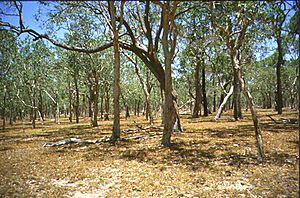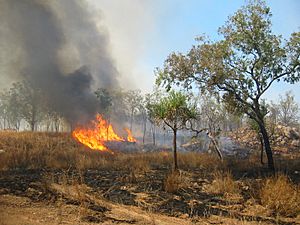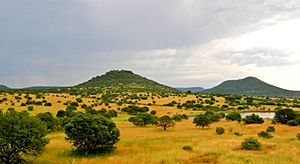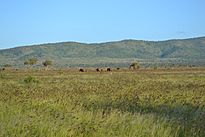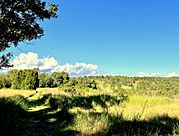Savanna facts for kids
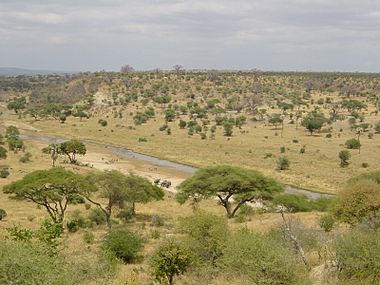
A savanna is a special kind of ecosystem that mixes woodland (areas with trees) and grassland (areas with lots of grass). In a savanna, trees are spread out enough so their tops (called the canopy) don't completely close over. This lets plenty of sunlight reach the ground. Because of this light, a thick layer of grass and other small plants can grow.
There are different types of savannas. Some have many trees and shrubs, forming a light canopy. Others have just a few scattered trees, or mostly shrubs. Some savannas are almost entirely made of grass, with very few trees or shrubs. Even though savannas look open, they can sometimes have as many trees as a forest! For example, some savannas in South America have a similar number of trees per hectare as nearby tropical forests.
Savannas also have a special climate. Most of their rain falls during one season, followed by a dry period. They are often found in areas between forests and deserts or grasslands. Savannas cover about 20% of the Earth's land. Unlike prairies or steppes, which have cold winters, savannas are usually in warm or hot places. You can find them in Africa, Australia, South America, and India.
Contents
What is a Savanna?
The word "savanna" comes from the Spanish word sabana. This word itself came from the Taíno language, spoken by people in the Caribbean. In Taíno, it meant "treeless grassland." When the Spanish word was written in English, the 'b' sound, which is like an English 'v' in the middle of a word, became a 'v'.
The word first appeared in English in 1555. It was used to describe a plain in what is now Panama.
Where Savannas Are Found
For a long time, many grassy areas with scattered trees were called savannas. Later, people started linking savannas to a specific type of tropical climate. However, the way we use the word "savanna" to describe plants can sometimes be different from how climate maps show them. This means some large savanna areas, like those near the Congo River and Amazon River, might not always be labeled as savannas on climate maps.
In North America, "savanna" has been used to describe similar areas like "barrens," "prairies," and "oak openings." It can be tricky to say exactly where a woodland ends and a savanna begins. Both have open trees where the branches usually don't touch.
The amount of rainfall in savannas changes a lot each year. They also often have wildfires during the dry season. Rainfall usually ranges from 500 to 1,270 mm (20 to 50 inches) per year. Most of this rain falls over six to eight months, followed by a dry spell.
Savanna Plants and Animals
Savannas are home to many different kinds of plants and animals.
Savanna Plants (Flora)
In the tropical savannas of America, you'll find broadleaf trees like Curatella and Byrsonima. Common grasses include Leersia and Paspalum. In Argentina, a bean-like plant called Prosopis is common.
East African savannas have trees like Acacia, Combretum, baobabs, and Palmyra palms. Drier parts have spiny shrubs and grasses such as Andropogon. Wetter savannas might have Brachystegia trees and tall elephant grass. West African savannas feature trees like Anogeissus and Strychnos.
Indian savannas, many of which have been cleared, still have Acacia, Mimosa, and Zizyphus trees in protected areas. They grow over grasses like Sehima. Australian savannas are full of eucalyptus trees and other evergreen plants. You'll also see Acacia, Bauhinia, and Pandanus plants, along with grasses like Heteropogon and kangaroo grass.
Savanna Animals (Fauna)
The African savanna is famous for its large animals. You can find giraffes, elephants, buffalos, zebras, gnus, hippopotamuses, rhinoceroses, and antelopes. These animals depend on the grasses and tree leaves to survive.
In the Australian savanna, kangaroos and wallabys are common. However, humans have also brought in animals like cattle, horses, camels, and Asian water buffalo.
Threats to Savannas
Sadly, less than three percent of savanna ecosystems are still in their natural state. Many things cause savannas to change and become less healthy.
Changes in Fire Management
Savannas often have natural wildfires. These fires are a normal part of the ecosystem. For a long time, people like Native Americans and Aboriginal people in Australia used controlled fires. These fires helped keep the savanna open by burning small plants and preventing larger, more damaging fires. This also helped create different habitats for animals and plants.
When these traditional burning methods stop, savannas can become overgrown with forests and thick shrubs. This means less grass grows, which affects animals that eat grass. Also, if there are fewer small fires, more fuel builds up. This can lead to much bigger, more dangerous wildfires that cause more damage to trees and the whole ecosystem.
The introduction of grazing animals can also reduce the amount of fuel for fires. This leads to fewer and cooler fires, which can allow more trees to grow and change the savanna.
Grazing Animals

Unlike dense forests, savannas have open areas with lots of grass, making them perfect for grazing animals. Many savannas around the world are used for grazing sheep, goats, and cattle. This grazing can change the types of plants that grow there.
When animals eat a lot of grass, it can help trees grow because there's less competition for water. It also reduces the fuel for fires, which means fewer fires to control tree growth. However, if animals eat too many young trees, it can also change the savanna. Sometimes, plants that animals don't like to eat can increase.
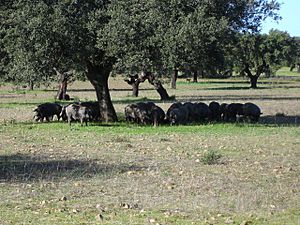
Grazing animals can also spread the seeds of unwanted plants, called weeds. They can also damage the soil by compacting it with their hooves or causing erosion if too much plant cover is removed. This is especially true in areas with low rainfall or poor soil. Changes in soil can affect how plants grow, which then changes the savanna's structure.
Tree Clearing
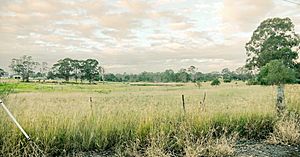
Large parts of savannas in Australia and South America have been cleared of trees. This is often done to create more land for grazing animals. Removing trees means more water is available for grasses, which can make the pasture grow much better. This helps farmers financially and makes it easier to manage livestock.
Farmers use different ways to clear trees. In the past, they would cut down trees or remove a ring of bark to kill them. Later, machines were used to push over or pull out trees. Chemicals were also developed to kill trees without cutting them.
Even after clearing, many woody plants can survive as small seedlings or by regrowing from their roots. This means that even after a lot of trees are removed, a good number of woody plants can still remain.
New Plant Species
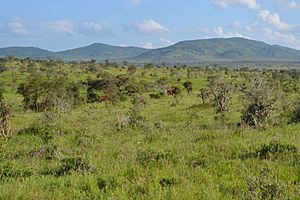
Many new plant species, called exotic species, have been brought into savannas around the world. Some of these are harmful weeds, like Prickly Acacia, Rubbervine, and Mesquite. Other grasses and legumes (plants like beans) have also been introduced.
These new plants can greatly change savannas. They can alter how fires behave, increase grazing pressure, compete with native plants, and take over spaces where native plants used to grow. This can harm the natural balance of the savanna ecosystem. Other plants found in savannas include white sage, spotted cactus, cotton seed, and rosemary.
Climate Change
Changes in the Earth's climate, caused by the greenhouse effect, might also affect savannas. Some scientists think that savannas might see more woody plants growing in them due to global warming. However, in some cases, savannas have actually expanded into forest areas because of climate changes. This shows that climate change can cause big, fast shifts in where different types of plants grow, especially in areas like savannas that are already a mix of different ecosystems.
Types of Savanna Ecoregions
Savannas can be divided into two main types:
- Open savanna: Where grass is the main plant and trees are rare.
- Wooded savanna: Where trees are denser, almost like an open forest.
Here are some specific types of savanna ecoregions:
- Tropical savannas: These are found in warm, tropical areas. Famous examples include the Serengeti in Africa, known for its amazing wildlife, and the Brazilian savanna (Cerrado), which has many unique plants.
- Subtropical and temperate savannas: These are found in middle latitudes. They have wetter summers and drier winters. You can find them in places like southeastern Australia, northern India, and parts of South America.
- Mediterranean savannas: These savannas are in regions with a Mediterranean climate. This means they have mild, rainy winters and hot, dry summers. The oak tree savannas in California are an example.
- Flooded savannas: These savannas are flooded either during certain seasons or all year round. They are mostly found in tropical and subtropical areas. The Everglades in Florida and the Pantanal in South America are well-known examples.
- Montane savannas: These are savannas found in high mountain regions. The Bogotá savanna in the Andes mountains of Colombia is an example, located at a high altitude.
See also
 In Spanish: Sabana para niños
In Spanish: Sabana para niños



